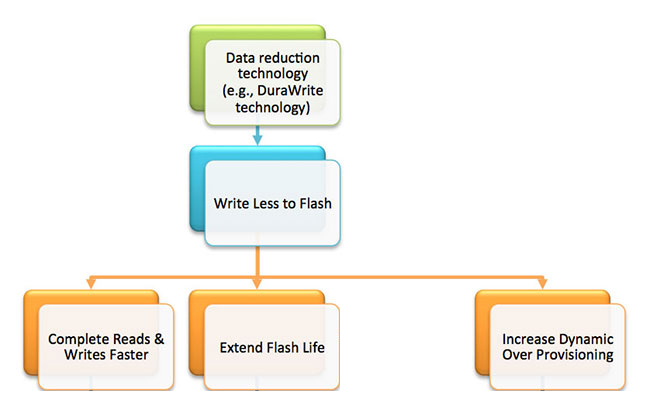In part one of this Write Amplification (WA) series, I examined how WA works in basic solid-state drives (SSDs). Part two now takes a deeper look at how SSDs that use some form of data reduction technology can see a very big and positive impact on WA.
Data reduction technology can master data entropy
The performance of all SSDs is influenced by the same factors — such as the amount of over provisioning and levels of random vs. sequential writing — with one major exception: entropy. Only SSDs with data reduction technology can take advantage of entropy — the degree of randomness of data — to provide significant performance, endurance and power-reduction advantages.
Data reduction technology parlays data entropy (not to be confused with how data is written to the storage device — sequential vs. random) into higher performance. How? When data reduction technology sends data to the flash memory, it uses some form of data de-duplication, compression, or data differencing to rearrange the information and use fewer bytes overall. After the data is read from flash memory, data reduction technology, by design, restores 100% of the original content to the host computer This is known as loss-less data reduction and can be contrasted with lossy techniques like MPEG, MP3, JPEG, and other common formats used for video, audio, and visual data files. These formats lose information that cannot be restored, though the resolution remains adequate for entertainment purposes.
The multi-faceted power of data reduction technology
My previous blog on data reduction discusses how data reduction technology relates to the SATA TRIM command and increases free space on the SSD, which in turn reduces WA and improves subsequent write performance. With a data-reduction SSD, the lower the entropy of the data coming from the host computer, the less the SSD has to write to the flash memory, leaving more space for over provisioning. This additional space enables write operations to complete faster, which translates not only into a higher write speed at the host computer but also into lower power use because flash memory draws power only while reading or writing. Higher write speeds also mean lower power draw for the flash memory.
Because data reduction technology can send less data to the flash than the host originally sent to the SSD, the typical write amplification factor falls below 1.0. It is not uncommon to see a WA of 0.5 on an SSD with this technology. Writing less data to the flash leads directly to:
- Faster read and write speed
- Increased dynamic over provisioning
- Extended flash life
Each of these in turn produces other benefits, some of which circle back upon themselves in a recursive manner. This logic diagram highlights those benefits.
So this is a rare instance when an amplifier — namely, Write Amplification — makes something smaller. At Seagate, this unique amplifier comes in the form of the SandForce DuraWrite data reduction technology in all SandForce Driven SSDs.
This three-part series examines some of the details behind write amplification, a key property of all NAND flash-based SSDs that is often misunderstood in the industry.
Part 1: Why SSDs hate amplification
Part 3: How to measure what can’t be seen









Leave A Comment